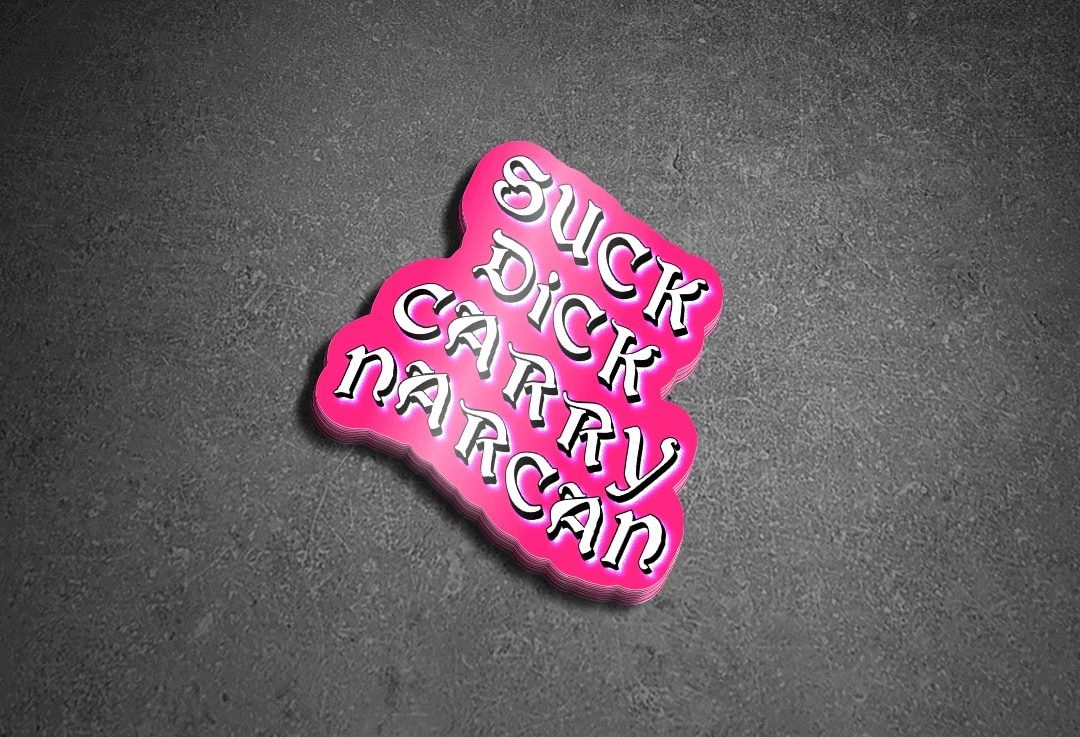The makeshift harm reduction center quietly popped up in Chelsea, one of the historically gay neighborhoods of Manhattan. Tucked away on the second floor of the LGBT Community Center, it was technically a bathroom. But the pastel roses lining the sink and a metal frame clutching iridescent packets of colorful clipped straws and bubblegum-pink sterile water transformed it into something else.
Participants were there for an annual exhibition by Queer|Art, a group that pairs rising LGBTQ+ artists with seasoned mentors, on November 1. Ripley Soprano, a non-binary organizer, writer and Queer|Art Literature Fellow behind the installation, provided colorful safer inhalation kits and harm reduction literature in the slender all-gender restroom. It was simple, but embodied a running theme in Soprano’s work: harm reduction as a fundamentally immanent, participatory practice. It can happen anywhere, anytime, and by anyone. You just need to make the space for it.
Participants speak with Ripley Soprano at their pop-up harm reduction center.
A former editor at Mask Magazine, a publication on youth and internet culture, and current collaborator with the feminist skate wear collective BRUJAS, Soprano is one artist giving increasingly-medicalized harm reduction supplies the queer style they desperately deserve.
“What if the whole kit was super-vibrant and didn’t look so clinical? What if it was both a piece of utility and a piece of political propaganda?” they told me. By political propaganda, Soprano suggests that bringing queer aesthetics to safer use kits resists the public health establishment’s efforts to standardize, discipline and make “less threatening,” as they described, harm reduction practices innovated by people who use drugs.
“I feel like the process of institutionalizing harm reduction really took the faggotry and sluttiness out of it, which makes me so sad,” they said, “especially because we know that so much of harm reduction practices and theories came out of sex working communities, people who are chemically dependent, sick and disabled people, and communities of care made up of gay men of color and trans women of color.”
“Suck Dick Carry Narcan” stickers designed by Soprano and herbalist Jade Marks. Photo courtesy of Soprano.
Many of the staples of harm reduction came from the ingenuity of drug users. Strategies like heroin buyer’s clubs, “going slow,” safer consumption spaces, naloxone distribution and drug checking all continue to be refined by people who use degrees even in the shadow of criminalization. The “hammer,” a pipe for safer heroin use, was designed by Shilo Jama, a drug user organizer in Seattle, as Filter recently reported.
The grassroots genealogy of harm reduction is central to Soprano’s work. Their art aims to create “different aesthetic projects as a road map both back to historical harm reduction organizing like the detox program at the occupation of Lincoln Hospital in Harlem by the Young Lords (1970), and Clean Needles Now! (1992) in Los Angeles, as well as the futurism of trans and sex worker-centered harm reduction that I dream for.”
As for many people, harm reduction is personal to Soprano. “Harm reduction has always been a way that people have shown their love to me, and that I’ve been able to give mine,” they said, referring to a person they fell in love with in high school who used drugs intravenously. “He would always call me when he was using. We would stay on the phone for a while and if he would nod off, we had a safety/emergency plan.”
Before that, Soprano had grown up around “a lot” of people who both used drugs or were recovering from problematic use. They later met someone while attending Brooklyn College who “taught me a lot of best practices for my own using, which was life-saving over and over again.”
Straying from harm reduction’s roots with people who devised strategies for survival on the fly is to the detriment of institutionalized care programs, Soprano argues—suggesting that public health programs have “a hard time tapping into an aesthetic that would make harm reduction appealing en masse” because it “relies on and leans on a certain amount of respectability, which will always leave out people on the margins who harm reduction theory was and is for and by. I also just think that truly, at the end of the day, everything the state does is extremely corny.”
Soprano wrote and produced a video for BRUJAS on harm reduction, released in June 2019.
Beyond the kits, Soprano envisions a grassroots movement of queer harm reductionists organizing around the oversight of state institutions. For them, this could look like “a series of almost federated harm reduction networks based on region and specific community needs and drug use practices,” and that would develop “tool kits and road maps that are flexible and non-dogmatic enough to be used in different contexts.”
It seems that the desire for a beautiful, democratic harm reduction practice is shared by many. Stickers that Soprano designed in collaboration with NYC-based herbalist Jade Marks—printed with text like “Suck Dick Carry Narcan,” “Sissies for Safe Injection Sites” and “Dependent”—seem to have tapped into a bubbling desire. Three batches of the Instagram-ready “Suck Dick Carry Narcan” stickers sold out back to back, the designers said.
I first learned of Soprano’s work from widely shared images of the stickers on Instagram. For me, the resonance of this work goes beyond consumer lust; it inspired me to meld queer style with the methamphetamine-specific safer use kits I’m assembling and distributing to trans women and gay men with other organizers, including Soprano, through our new project, Do It Safe, Heaux!.
Soprano’s work provides a refreshing visual palette for harm reductionists to experiment with the orientation of our movement—hopefully, for the gayer.
Photograph of Ripley Soprano’s safer use kits at their November 1 installation; By Filter







Show Comments